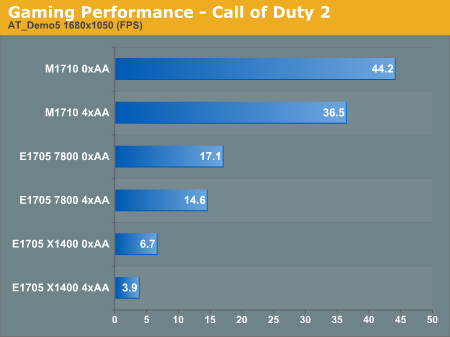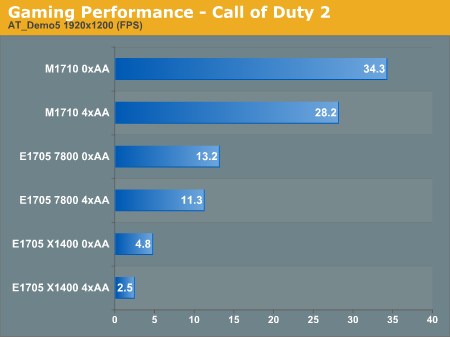Dell DTR Laptop Shootout - M1710 vs. E1705
by Jarred Walton on May 30, 2006 1:30 PM EST- Posted in
- Laptops
Gaming Performance: Call of Duty 2
Call of Duty 2 is interesting because it's one of the few games touted as supporting SMP. (We will get to Quake 4 later, and we don't have results from Oblivion for this article. Without seriously reducing graphics quality, Oblivion is only playable on the M1710.) We're running with the official version 1.2 patch, with high-quality lighting, anisotropic filtering, and maximum (Extra) texture sizes on everything but the specular highlights, which are set to high detail. We also enabled "Optimize for SLI" on all three systems, and it appears that the setting might actually be better labeled as "Optimize for SMP". We aren't entirely sure how the game and driver settings are changed at this time, but CPU usage on dual core systems definitely increases when it is enabled, and frame rates are improved quite a bit as well - at least in situations where we're not GPU limited.


As before, the X1400 configuration makes a dismal showing. (After finishing the Call of Duty 2 benchmarks, we decided it was pointless to continue benchmarking 4xAA on the X1400.) You can also see that while the GeForce Go 7800 is at least twice as fast as the X1400, it struggles with the latest games on high-quality settings as well. The clock speeds of the GeForce Go 7800 are quite low relative to desktop 7800 cards (it's clocked at 250/658 instead of the 425/1000 clock speeds that desktop models carry), and combined with the fact that it has 12 pixel pipelines versus 24 on the GeForce Go 7900 GTX and it's easy to see why it's less than half as fast. Of course, it also costs about one fourth as much. (The GeForce Go 7800 is a $200 upgrade from Dell, and the GeForce Go 7900 GTX is a $400 upgrade from the 7800 GS, which is already a $350 upgrade.)










34 Comments
View All Comments
RedStar - Wednesday, May 31, 2006 - link
"NVIDIA's rating of 400 MHz does not mean manufacturers have to run it that fast"Nvidia's rating very much means the mobile part is capable of 400Mhz --anything less is an underclock.
Why on earth would nvidia publish a spec with the expectation that no one would follow it?
Heck, they could just say we have an 1000Mhz mobile core but too bad everyone will make it go 180Mhz.
Since people are running the go 7800 at 390+MHz without a power upgrade, i would have to say you are very much mistaken about the power draw.
But, i would say the primary issue was two fold.
1)Heat output (thermal profile)
2)To differentiate the product enough from Dell's similiar but ultra expensive XPS line
(of the same february time frame)
I, and others, tend to believe dell was concerned more about #2.
JarredWalton - Thursday, June 1, 2006 - link
NVIDIA wants to put the best face on its product. Just because the chip will run at 400 MHz doesn't mean it can do so within the thermal envelope a manufacturer has for a laptop. I've heard people complain about overheating issues with high-end laptops already, so if Dell plays it a bit safe I won't complain too loudly. I'd really like 1000 MHz RAM with a 333 core say over 400 core and 650-700 RAM.As for protecting the XPS line, the 7900 GS basically fills in the gap. I personally think the GF Go 7800 is going into E1705 because Dell had a bunch of extras from older XPS models. They're downclocking them to reduce power and heat. At 94W measured peak, I would certainly be concerned about long-term usage of a 90W power brick. Unless the 90W rating is conservative, but then why have a 130W for the XPS line?
Anyway, look at the battery life of the 7800 Go compared to the 7900 GTX Go, and then increase the GPU performance by 60%. If you can't have the GPU fall back to the same level (1.1 V and 100 MHz core/658 MHz RAM or something), there are good reasons to not ship a faster GPU. I *still* don't recommend the 7800 Go version, as you would be better with either more battery life (X1400) or better gaming (7900 GS). I just tested what I was sent.
RedStar - Thursday, June 1, 2006 - link
I would agree, the introduction of the 7900GS makes this moot to everyone --except those that bought the i9400 when it first came out and had only the go7800 to choose from (with no reviews yet available --except for the one that said the go 7800 was equal to the ati x1400 [we all then found out why --Dell's 260 core!!]).The limited possibility of a 7900GS upgrade sounds, at least, hopeful.
:)
Andyvan - Wednesday, May 31, 2006 - link
I bought my wife an E1705 a couple of months ago. She doesn't game, so I went with the MX1400. I also went with the slower disk, hoping that would yield lower heat/noise, and longer battery life. I'm curious as to whether I chose well.-- Andyvan
JarredWalton - Wednesday, May 31, 2006 - link
The 7200 RPM HDD kicks power draw up about 2 W when it's active versus sleeping. Really, most laptop parts are already very low power. The X1400 consumes 28W total when idle - most desktops use that much just for the motherboard. The 7200 RPM drives will run slightly warmer than the 5400 RPM models, but they are also about 30% faster in HDD performance. Adding more RAM will often make HDD performance less important, but if you copy files around on the HDD you will definitely notice the difference.Warder45 - Wednesday, May 31, 2006 - link
What about the noise difference in 5400 vs 7200? I've heard that the 7200 HD's can be a lot louder.Yianaki - Wednesday, May 31, 2006 - link
Why can't you have a top of the line 7900 GTX and when watching a DVD or the xp desktop doesn't the graphics card go into basically a sleep mode and turn of almost all the memory. HELL why don't they add a crappy additional teeny transistor space to the gpu chip if it is sooo hard to get the power requirements down on the main GPU. That way they can turn off most of the ram and the gpu and just use this additional teeny transistor space to run simple XP desktop functions or while playing DVD's. I mean a simple xp desktop functions can't take up that much die space. I simply don't get it. I mean this is like the nth graphics card from nvidia and yet it still sucks up the power. I have the horrible intel onboard graphics on my laptop and apart from it eating up some of my precious ram I am EXTREMELY happy with it doing regular desktop XP tasks. Sucks ass for gaming of course. I mean how hard is it for nvidia to totally turn off pretty much all of the GPU when just in desktop mode. Is the huge power difference just because of the high performance memory used? There really shouldn't be a penalty for getting top o' the line graphics I believe.mindless1 - Tuesday, May 30, 2006 - link
From the article,"Why would anyone want to get the X1400 in such a laptop? Obviously, because it uses far less power than even the GeForce Go 7800."
More like, most people are not gamers and of those who are, many will prefer gaming on their desktop. The % of people that will buy a laptop with gaming in mind is miniscule, and that brings up the other puzzling part about so many gaming benchmarks of laptops instead of more useful things like HDD & office productivity. Sure, anything can run office but what about working with giant databases, or wifi range, or most of the parameters that matter to most prospective laptop buyers. Gaming just isn't important at all if it were the same price. Now subtract the price difference and you see why anyone, actually most people do not pay for the gaming GPU inside.
Blahman - Wednesday, May 31, 2006 - link
Hardly... notebook sales have surpassed desktop sales recently.Desktops are on the way out if you ask me. Even if you're a gamer. There are notebooks out there already that have SLI, and the Core Duo architecture is the future of all Intel processors, and it STARTED in notebooks.
Every new notebook generation closes the performance and price gap between desktops and notebooks.
I recently configured and ordered a nice E1705 with the 7900 GS (which I really wish AnandTech had included in the benchmarks, it's more than twice as fast as the 7800 Go) for $1250 (with a $750 coupon code). Skimp on the RAM and go for a $180 aftermarket 2GB PC2-5300 upgrade.
Later on down the road you will be able to upgrade to Merom, and possibly the 7900 GTX or G80M. For now Dell is keeping their spare 7900 GTXs for warranty repairs and aren't currently for sale, but like the last generation with the 7800 GTX, it may be available in the future from Dell Spare Parts.
For tons of more info about these models check out http://www.notebookforums.com/forumdisplay.php?f=1...">the Dell 17" Notebooks section at notebookforums.com.
ElFenix - Tuesday, May 30, 2006 - link
who buys a 9 pound notebook with somewhat horrific battery life regardless unless they're gaming? an external display hooked up to a 15" or 14" 6 pound notebook would be far more useful to the user you're describing.and don't forget that this IS a gaming oriented website.